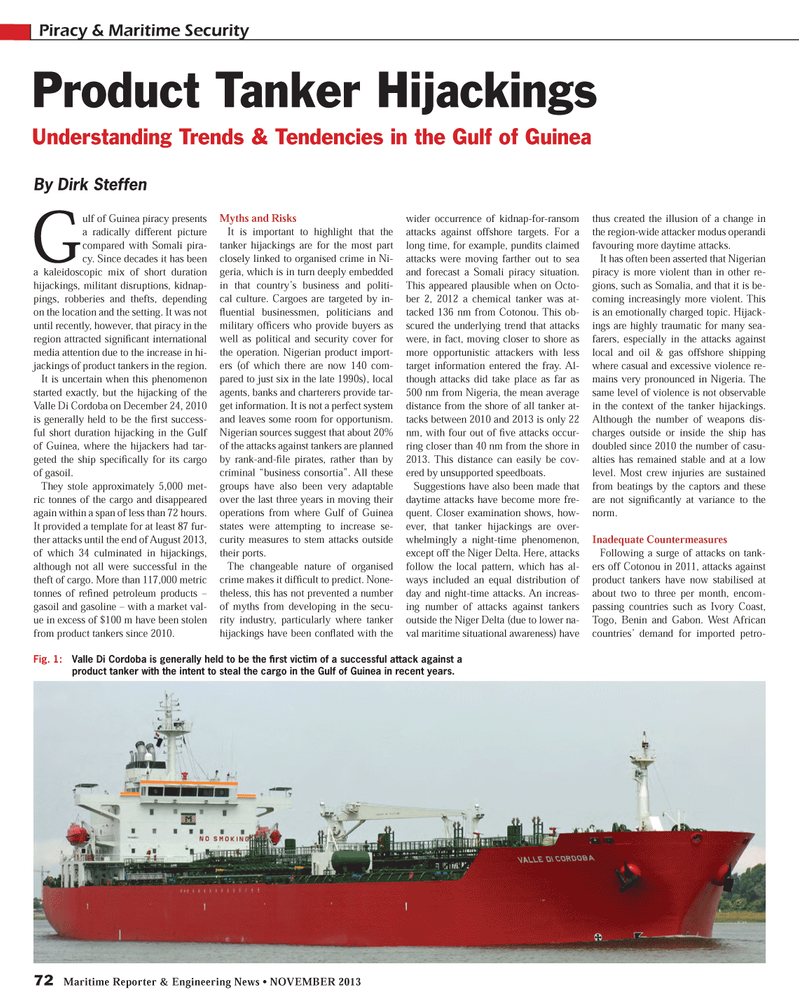
Page 72: of Maritime Reporter Magazine (November 2013)
Marine Propulsion Annual
Read this page in Pdf, Flash or Html5 edition of November 2013 Maritime Reporter Magazine
72 Maritime Reporter & Engineering News ? NOVEMBER 2013 Gulf of Guinea piracy presents a radically different picture compared with Somali pira-cy. Since decades it has been a kaleidoscopic mix of short duration hijackings, militant disruptions, kidnap-pings, robberies and thefts, depending on the location and the setting. It was not until recently, however, that piracy in the region attracted signiÞ cant international media attention due to the increase in hi-jackings of product tankers in the region.It is uncertain when this phenomenon started exactly, but the hijacking of the Valle Di Cordoba on December 24, 2010 is generally held to be the Þ rst success- ful short duration hijacking in the Gulf of Guinea, where the hijackers had tar- geted the ship speciÞ cally for its cargo of gasoil. They stole approximately 5,000 met-ric tonnes of the cargo and disappeared again within a span of less than 72 hours. It provided a template for at least 87 fur- ther attacks until the end of August 2013, of which 34 culminated in hijackings, although not all were successful in the theft of cargo. More than 117,000 metric tonnes of reÞ ned petroleum products ? gasoil and gasoline ? with a market val-ue in excess of $100 m have been stolen from product tankers since 2010.Myths and RisksIt is important to highlight that the tanker hijackings are for the most part closely linked to organised crime in Ni-geria, which is in turn deeply embedded in that country?s business and politi- cal culture. Cargoes are targeted by in- ß uential businessmen, politicians and military ofÞ cers who provide buyers as well as political and security cover for the operation. Nigerian product import-ers (of which there are now 140 com-pared to just six in the late 1990s), local agents, banks and charterers provide tar- get information. It is not a perfect system and leaves some room for opportunism. Nigerian sources suggest that about 20% of the attacks against tankers are planned by rank-and-Þ le pirates, rather than by criminal ?business consortia?. All these groups have also been very adaptable over the last three years in moving their operations from where Gulf of Guinea states were attempting to increase se-curity measures to stem attacks outside their ports.The changeable nature of organised crime makes it difÞ cult to predict. None- theless, this has not prevented a number of myths from developing in the secu-rity industry, particularly where tanker hijackings have been conß ated with the wider occurrence of kidnap-for-ransom attacks against offshore targets. For a long time, for example, pundits claimed attacks were moving farther out to sea and forecast a Somali piracy situation. This appeared plausible when on Octo-ber 2, 2012 a chemical tanker was at-tacked 136 nm from Cotonou. This ob- scured the underlying trend that attacks were, in fact, moving closer to shore as more opportunistic attackers with less target information entered the fray. Al- though attacks did take place as far as 500 nm from Nigeria, the mean average distance from the shore of all tanker at-tacks between 2010 and 2013 is only 22 nm, with four out of Þ ve attacks occur- ring closer than 40 nm from the shore in 2013. This distance can easily be cov- ered by unsupported speedboats.Suggestions have also been made that daytime attacks have become more fre-quent. Closer examination shows, how-ever, that tanker hijackings are over- whelmingly a night-time phenomenon, except off the Niger Delta. Here, attacks follow the local pattern, which has al-ways included an equal distribution of day and night-time attacks. An increas- ing number of attacks against tankers outside the Niger Delta (due to lower na-val maritime situational awareness) have thus created the illusion of a change in the region-wide attacker modus operandi favouring more daytime attacks.It has often been asserted that Nigerian piracy is more violent than in other re-gions, such as Somalia, and that it is be-coming increasingly more violent. This is an emotionally charged topic. Hijack- ings are highly traumatic for many sea-farers, especially in the attacks against local and oil & gas offshore shipping where casual and excessive violence re-mains very pronounced in Nigeria. The same level of violence is not observable in the context of the tanker hijackings. Although the number of weapons dis-charges outside or inside the ship has doubled since 2010 the number of casu-alties has remained stable and at a low level. Most crew injuries are sustained from beatings by the captors and these are not signiÞ cantly at variance to the norm.Inadequate Countermeasures Following a surge of attacks on tank- ers off Cotonou in 2011, attacks against product tankers have now stabilised at about two to three per month, encom-passing countries such as Ivory Coast, Togo, Benin and Gabon. West African countries? demand for imported petro- Piracy & Maritime SecurityProduct Tanker Hijackings Understanding Trends & Tendencies in the Gulf of Guinea By Dirk Steffen Fig. 1: Valle Di Cordoba is generally held to be the Þ rst victim of a successful attack against a product tanker with the intent to steal the cargo in the Gulf of Guinea in recent years. MR #11 (66-73).indd 72MR #11 (66-73).indd 7211/12/2013 10:42:53 AM11/12/2013 10:42:53 AM

 71
71

 73
73
